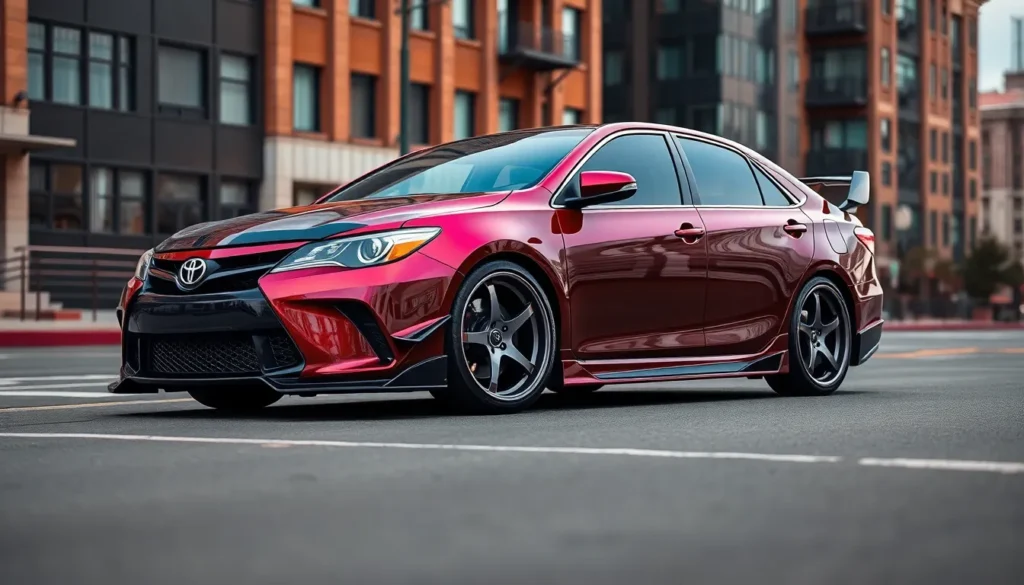The Toyota Camry has evolved from a reliable family sedan into one of the most popular platforms for automotive modification. We’ve witnessed countless enthusiasts transform their Camrys into stunning machines that rival high-performance sports cars while maintaining the practicality that made them fall in love with this iconic vehicle in the first place.
Whether you’re dreaming of a slammed stance build with aggressive aero kits or planning a sleeper setup with turbocharged power under the hood, the Camry’s versatility makes it an incredible canvas for customization. We’ve seen everything from track-focused builds to show-stopping street machines that turn heads at every corner.
What makes modified Camrys so appealing is their perfect balance of affordability and potential. With abundant aftermarket support and a strong community of builders sharing their knowledge, we’re here to guide you through the most effective modifications that’ll transform your Camry into something truly special.
What Makes the Toyota Camry a Popular Choice for Modifications
The Toyota Camry’s robust platform foundation creates an ideal starting point for performance modifications across multiple generations. Built with durable components and engineering tolerances that withstand increased power output, the Camry’s chassis accommodates forced induction setups and naturally aspirated builds equally well.
Aftermarket support for Camry modifications spans decades of production, offering extensive part availability from performance companies like AEM, K&N, and Injen. Engine bay space in the Camry provides sufficient room for cold air intakes, turbocharger installations, and intercooler mounting without major structural modifications. Suspension upgrade options include coilover systems from brands such as BC Racing, Tein, and KW Variant, allowing for precise ride height and handling adjustments.
Factory reliability characteristics make modified Camrys practical daily drivers that maintain their core functionality. Engine internals in 2.4L and 3.5L variants handle moderate power increases with stock components, reducing initial modification costs for enthusiasts. Transmission options like the 6-speed manual in certain model years support performance upgrades without requiring immediate drivetrain reinforcement.
Cost effectiveness of Camry modification projects stems from affordable base vehicle pricing and reasonable aftermarket component costs. Used Camry examples from 2007-2017 model years provide excellent modification foundations at price points between $8,000-$15,000. Performance parts pricing remains competitive due to high demand and multiple manufacturer options for common upgrades like exhaust systems, intake manifolds, and ECU tuning answers.
Community knowledge sharing accelerates Camry modification success through established forums like CamryForums.com and dedicated Facebook groups. Technical documentation and installation guides exist for popular modifications, reducing trial and error costs for new builders. Local car meets and online communities provide troubleshooting support and inspiration for unique build directions.
Popular Exterior Modifications for the Toyota Camry
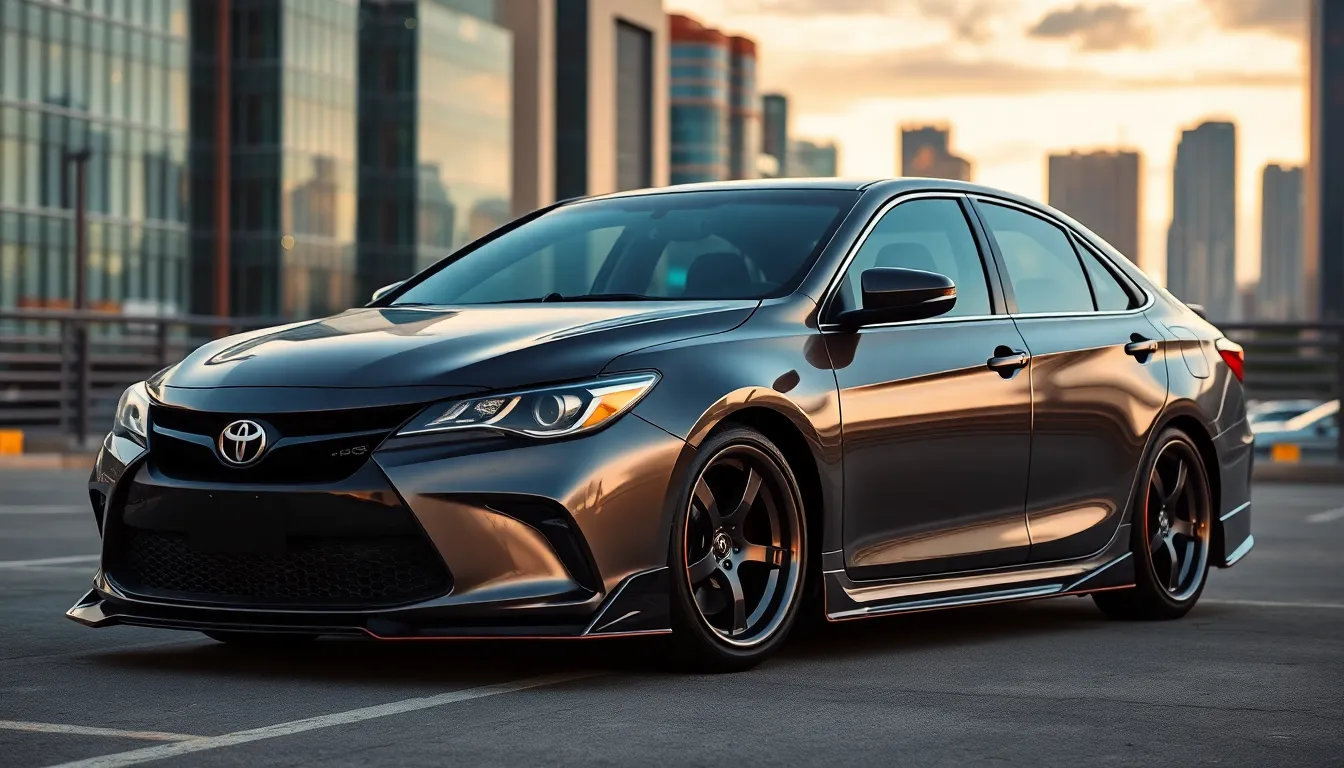
Exterior modifications transform the Toyota Camry’s conservative appearance into an aggressive and personalized statement. Visual enhancements create the most immediate impact when building a modified Camry that stands out from stock vehicles.
Body Kits and Aerodynamic Enhancements
Body kits revolutionize the Camry’s exterior profile by adding aggressive styling elements that enhance both appearance and performance. Complete body kits from manufacturers like Duraflex and Extreme Dimensions include front bumpers, side skirts, rear bumpers, and spoilers designed specifically for each generation.
Front lip spoilers create the most affordable entry point into aerodynamic modifications, with options ranging from $150-400 depending on material quality. Carbon fiber lips from companies like Seibon provide lightweight performance benefits while ABS plastic alternatives offer budget-friendly styling improvements.
Side skirts enhance the Camry’s ground effects by creating a lowered visual profile that connects the front and rear styling elements. Installation typically requires minimal cutting and mounting hardware, making these modifications accessible for DIY enthusiasts.
Rear spoilers and diffusers complete the aerodynamic package by improving airflow management at highway speeds. Duck tail spoilers deliver subtle enhancement while larger wing configurations provide more aggressive styling for track-focused builds.
Custom Paint Jobs and Vinyl Wraps
Paint modifications allow Camry owners to express unique personalities through color combinations and finish options not available from the factory. Professional paint jobs range from $2,000-8,000 depending on color complexity and preparation requirements.
Matte finishes create modern aesthetics that differentiate modified Camrys from glossy factory options. Colors like matte black, gunmetal, and military green provide striking appearances that complement aggressive body modifications.
Vinyl wraps offer reversible customization options with installation costs between $1,500-3,500 for complete vehicle coverage. 3M and Avery Dennison produce premium wrap materials that withstand weather conditions while maintaining color consistency.
Two-tone paint schemes combine contrasting colors to highlight body lines and create visual depth. Popular combinations include black roofs with colored bodies or accent panels that emphasize aerodynamic components.
Custom graphics and racing stripes add personality without requiring complete color changes. Digital printing technology enables complex designs, logos, and patterns that reflect individual styling preferences.
Wheel and Tire Upgrades
Wheel upgrades deliver the most important visual transformation for modified Camrys while improving handling characteristics and brake clearance. Aftermarket wheels range from 17-20 inches in diameter with various width options to accommodate performance tire selections.
Lightweight forged wheels from manufacturers like Enkei, Work, and Rays reduce unsprung weight by 5-8 pounds per corner compared to factory castings. Weight reduction improves acceleration, braking, and suspension response for enhanced driving dynamics.
| Wheel Size | Typical Weight Range | Performance Benefit |
|---|---|---|
| 18×8.5 | 18-25 lbs | Balanced performance and comfort |
| 19×9.5 | 22-28 lbs | Enhanced handling with minor comfort trade-off |
| 20×10 | 26-32 lbs | Maximum visual impact and grip |
Staggered wheel setups use wider rear wheels to improve traction and create an aggressive stance. Common configurations include 18×8 front with 18×9.5 rear or 19×8.5 front with 19×10 rear depending on performance goals.
Performance tires complement wheel upgrades by maximizing grip potential and handling precision. Summer compounds from Michelin, Continental, and Bridgestone provide superior dry traction while all-season options maintain year-round usability.
Lowering springs or coilover systems optimize wheel fitment by reducing wheel gap and improving overall proportions. Proper suspension tuning ensures wheels fill fender wells without causing clearance issues during compression or steering input.
Interior Modifications to Transform Your Camry
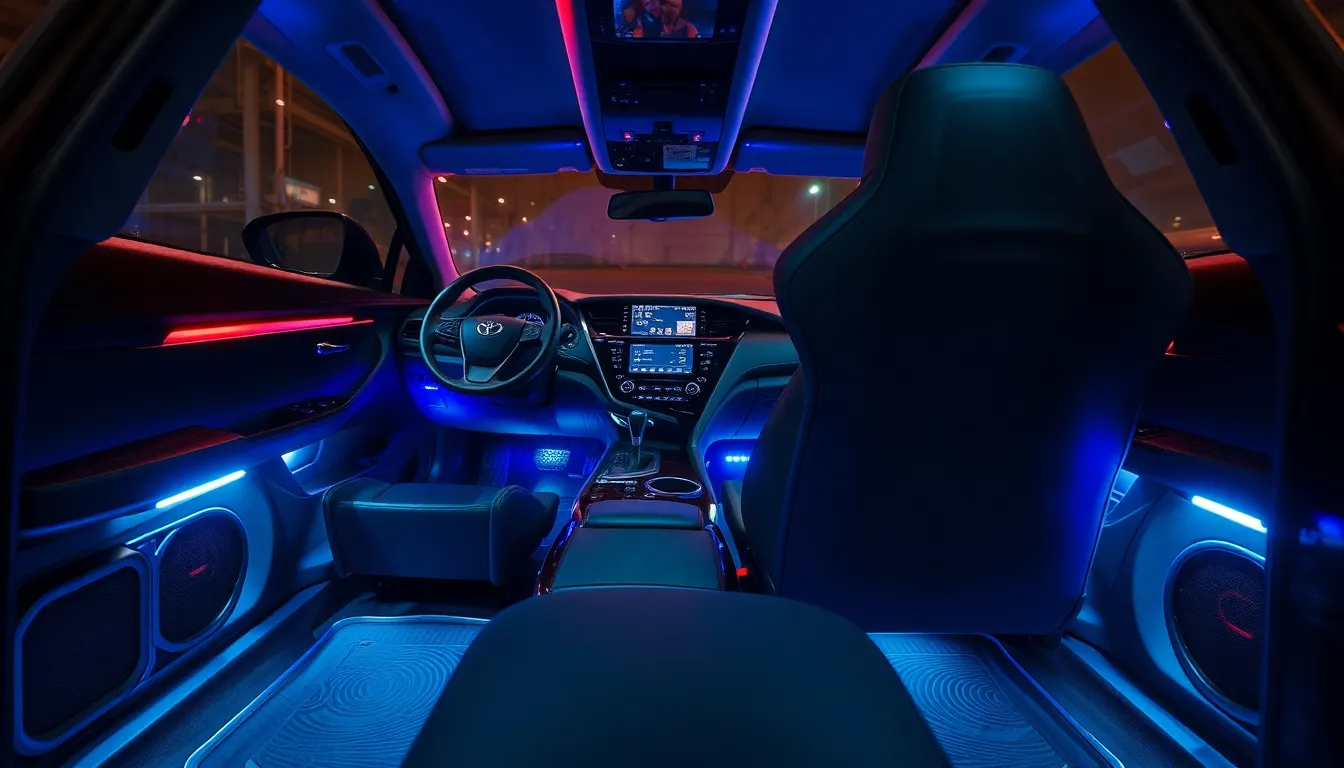
Interior modifications for the Toyota Camry create a personalized driving environment that matches your performance exterior upgrades. These enhancements range from technology upgrades to complete cabin transformations that elevate both aesthetics and functionality.
Dashboard and Infotainment Upgrades
Dashboard modifications transform the Camry’s factory setup into a modern command center with enhanced connectivity and visual appeal. Aftermarket double DIN head units from Pioneer, Kenwood, and Alpine integrate Apple CarPlay and Android Auto functionality while featuring 7-inch to 9-inch touchscreen displays. Carbon fiber dash kits replace plastic trim pieces with lightweight alternatives that reduce weight by 2-3 pounds while adding motorsport aesthetics.
Digital gauge clusters from companies like AEM and Innovate Motorsports provide real-time engine data including boost pressure, air-fuel ratios, and exhaust gas temperatures. Custom gauge pods mount additional analog gauges such as oil pressure, water temperature, and vacuum readings in A-pillar locations or dashboard cutouts. LED ambient lighting kits install behind dashboard panels and door cards to create customizable mood lighting in 16 million color combinations.
Performance data loggers like the AEM CD-5 or Haltech IC-7 replace traditional instrument clusters entirely with full-color displays showing engine parameters, lap times, and diagnostic information. These systems connect directly to engine management computers for precise monitoring during track sessions or daily driving conditions.
Seat and Upholstery Customization
Seat upgrades provide enhanced support and visual impact while maintaining daily driving comfort in modified Camrys. Racing seats from Recaro, Sparco, and Bride offer fixed-back designs with carbon fiber shells that reduce weight by 15-20 pounds per seat compared to factory units. These seats feature FIA certification for motorsport applications and include integrated harness mounting points.
Sport seats with adjustable bolsters from companies like Corbeau and NRG provide compromise answers between racing functionality and street comfort. Custom leather upholstery services reupholster factory seats with premium materials including Alcantara, genuine leather, and perforated sections with contrast stitching patterns. Color combinations range from subtle black and red accents to bold two-tone designs that complement exterior modifications.
Seat bracket systems from Planted Technology and Sparco ensure proper mounting heights and positions for aftermarket seats while maintaining safety standards. Custom door panels and headliner installations using matching materials create cohesive interior themes that extend modification aesthetics throughout the cabin.
Floor mat upgrades include custom-fit options from WeatherTech and Lloyd Mats featuring embroidered logos, colored binding, and premium carpet materials. Pedal sets from companies like NRG and Sparco replace factory rubber pedals with aluminum alternatives featuring anti-slip surfaces and aggressive styling that matches performance modifications.
Performance Modifications for Enhanced Power
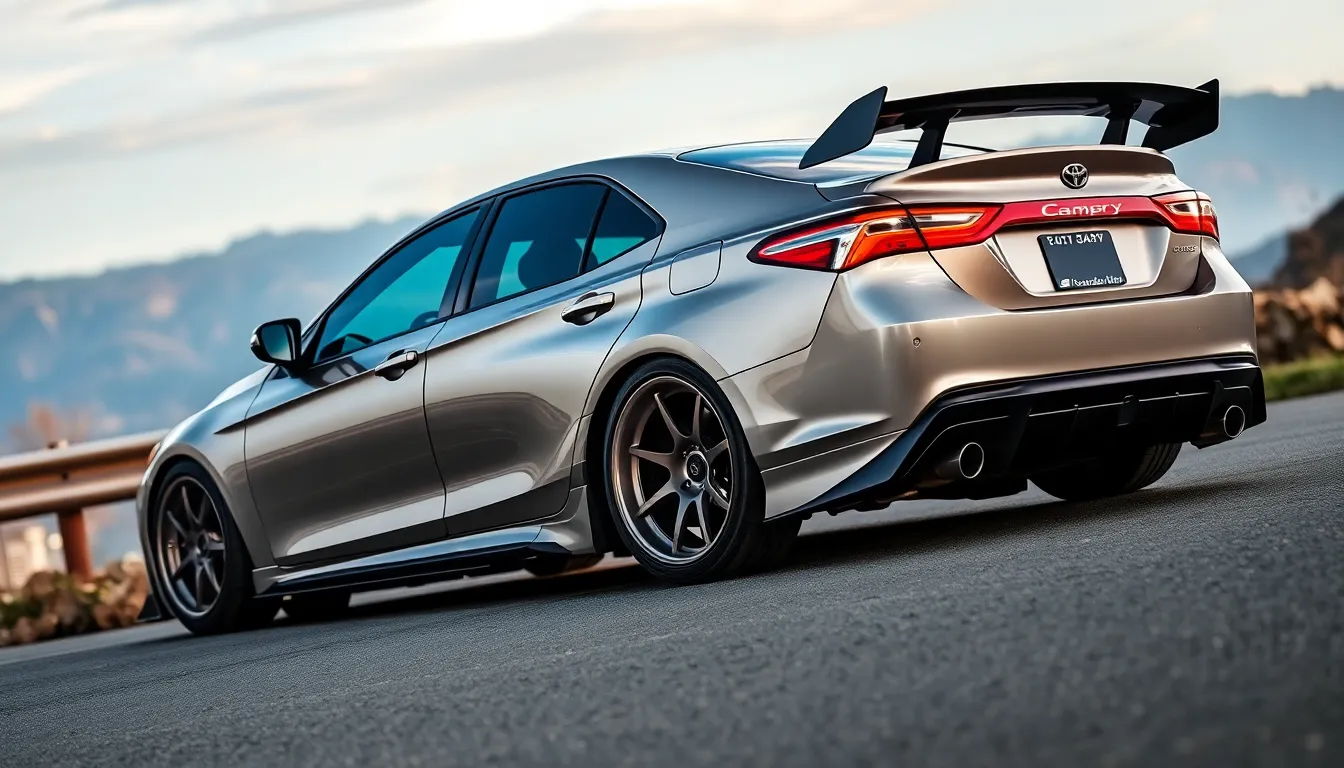
Performance modifications transform a Toyota Camry from a dependable daily driver into a ever-changing machine that delivers enhanced power and driving excitement. These upgrades target the three core areas that define automotive performance: engine output, exhaust flow, and chassis dynamics.
Engine Tuning and Cold Air Intakes
Engine tuning unlocks hidden potential within the Camry’s powerplant by optimizing fuel delivery and ignition timing parameters. Professional ECU tuning can increase horsepower by 15-25 hp on naturally aspirated 2.4L engines and up to 35-50 hp on the 3.5L V6 variants when combined with supporting modifications.
Cold air intake systems replace the restrictive factory airbox with high-flow components that draw cooler, denser air into the engine. Popular brands like AEM, K&N, and Injen offer direct-fit systems that increase airflow by 30-40% while producing a more aggressive intake sound. These systems typically deliver 8-15 hp gains on stock engines and create the foundation for more aggressive tuning modifications.
Throttle body spacers and performance air filters complement intake upgrades by further reducing airflow restrictions. Installing a larger throttle body increases airflow capacity, while high-flow drop-in filters maintain filtration efficiency while reducing intake restriction by up to 25% compared to paper elements.
Exhaust System Upgrades
Exhaust system modifications eliminate backpressure bottlenecks that limit engine breathing and power production. Cat-back exhaust systems from manufacturers like Borla, Magnaflow, and HKS replace the restrictive factory components with larger diameter piping and high-flow mufflers.
Performance exhaust manifolds or headers create the most important power gains by optimizing exhaust gas scavenging from the combustion chambers. Long-tube headers can increase power output by 12-20 hp on 4-cylinder engines and 18-30 hp on V6 models when combined with a complete exhaust system upgrade.
High-flow catalytic converters maintain emissions compliance while reducing exhaust restriction by up to 40% compared to factory units. These components work particularly well with turbo applications where exhaust backpressure directly impacts turbocharger efficiency and power production.
Exhaust diameter upgrades play a crucial role in power delivery characteristics. Systems measuring 2.5-3 inches in diameter optimize flow for naturally aspirated engines, while forced induction setups benefit from 3-3.5 inch systems that accommodate increased exhaust volume.
Suspension and Handling Improvements
Suspension modifications transform the Camry’s comfort-oriented chassis into a precision handling platform that maximizes tire contact and cornering capability. Coilover suspension systems from brands like BC Racing, KW, and Bilstein offer adjustable ride height and damping characteristics that can be tuned for exact driving conditions.
Performance springs and struts provide a more affordable entry point into suspension modification while delivering noticeable improvements in body roll reduction and steering response. These components typically lower the vehicle by 1-2 inches while maintaining acceptable ride quality for daily driving applications.
Anti-roll bars significantly reduce body roll during cornering by increasing chassis stiffness between the left and right sides of the vehicle. Front and rear sway bar upgrades can reduce cornering body roll by 40-60% while improving steering precision and driver confidence during aggressive driving.
Strut tower braces connect the suspension mounting points to increase chassis rigidity and improve suspension geometry consistency. These modifications prove particularly beneficial on older Camry models where chassis flex becomes more pronounced with increased mileage and spirited driving.
Performance bushings replace soft rubber components with firmer polyurethane or spherical bearings that eliminate suspension deflection under load. Control arm bushings, motor mounts, and transmission mounts create a more connected driving experience while reducing power transfer losses during acceleration.
Best Modified Toyota Camry Examples
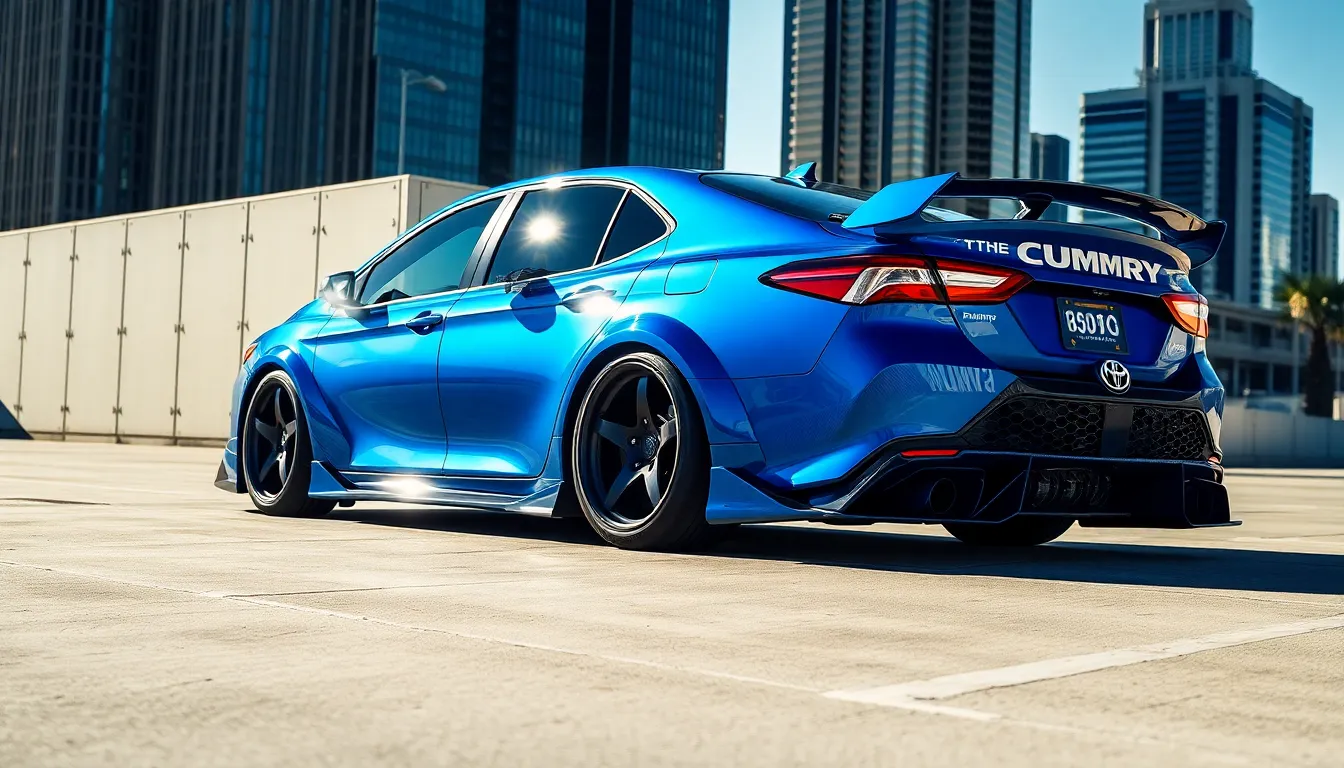
Modified Toyota Camrys showcase the platform’s remarkable transformation potential across different build philosophies. These examples demonstrate how enthusiasts achieve stunning results through strategic modifications that enhance both form and function.
Show Car Builds
Show car Camrys represent the pinnacle of automotive artistry where aesthetics take precedence over daily practicality. The 2018 Camry XSE built by Toyo Tires features a complete Rocket Bunny Pandem V1 widebody kit with custom metallic blue paint and 20×10.5 Vossen VF5 wheels. This build incorporates air suspension for adjustable ride height and 275/30R20 Toyo Proxes R888R tires that complement the aggressive stance.
Another standout example includes the 2015 Camry SE with a Liberty Walk body kit that transforms the sedan’s conservative profile into an exotic appearance. Custom carbon fiber splitters extend 6 inches beyond the factory bumper while side skirts reduce ground clearance to 3.2 inches. The interior features Recaro Pole Position seats with Alcantara upholstery and a custom roll cage that maintains structural integrity during transport.
Professional show builds often incorporate unique paint techniques like the 2020 Camry TRD with pearl white base coat and midnight blue accents applied through hydro-dipping. LED underglow systems with 16 million color combinations synchronize with custom sound systems that produce 3,000 watts through JL Audio components. These builds typically cost between $35,000 and $60,000 for complete transformations that compete at major automotive events.
Daily Driver Modifications
Daily driver Camrys balance performance enhancements with practical functionality that maintains reliability for commuting purposes. The 2012 Camry SE with Eibach Pro-Kit springs lowers the vehicle 1.4 inches front and 1.3 inches rear while preserving factory ride comfort for 50,000+ mile durability. K&N cold air intake systems increase airflow by 47% and add 12 horsepower without compromising fuel economy that averages 28 mpg city.
Popular daily builds feature modest wheel upgrades like 18×8 Enkei RPF1s that reduce unsprung weight by 8 pounds per corner compared to factory wheels. Continental ExtremeContact DWS06 tires in 225/45R18 size provide all-season traction while maintaining 40,000-mile tread life warranties. Borla ATAK cat-back exhaust systems add aggressive sound without drone during highway cruising at 2,200 RPM.
Performance daily drivers often incorporate ECU tuning through companies like Orange Virus Tuning that optimize fuel maps for 93 octane gasoline. These tunes extract 25-30 additional horsepower from 2AR-FE engines while maintaining factory reliability standards. Interior upgrades focus on functionality with OEM+ modifications like leather-wrapped steering wheels and aluminum pedal covers that enhance the driving experience without sacrificing comfort during 45-minute commutes.
| Modification Category | Show Car Investment | Daily Driver Investment |
|---|---|---|
| Body Kit | $8,000-$15,000 | $2,500-$5,000 |
| Paint/Wrap | $5,000-$12,000 | $1,500-$3,500 |
| Wheels/Tires | $4,000-$8,000 | $1,800-$3,200 |
| Suspension | $3,500-$7,000 | $1,200-$2,800 |
| Interior | $6,000-$12,000 | $800-$2,000 |
Cost Considerations for Camry Modifications
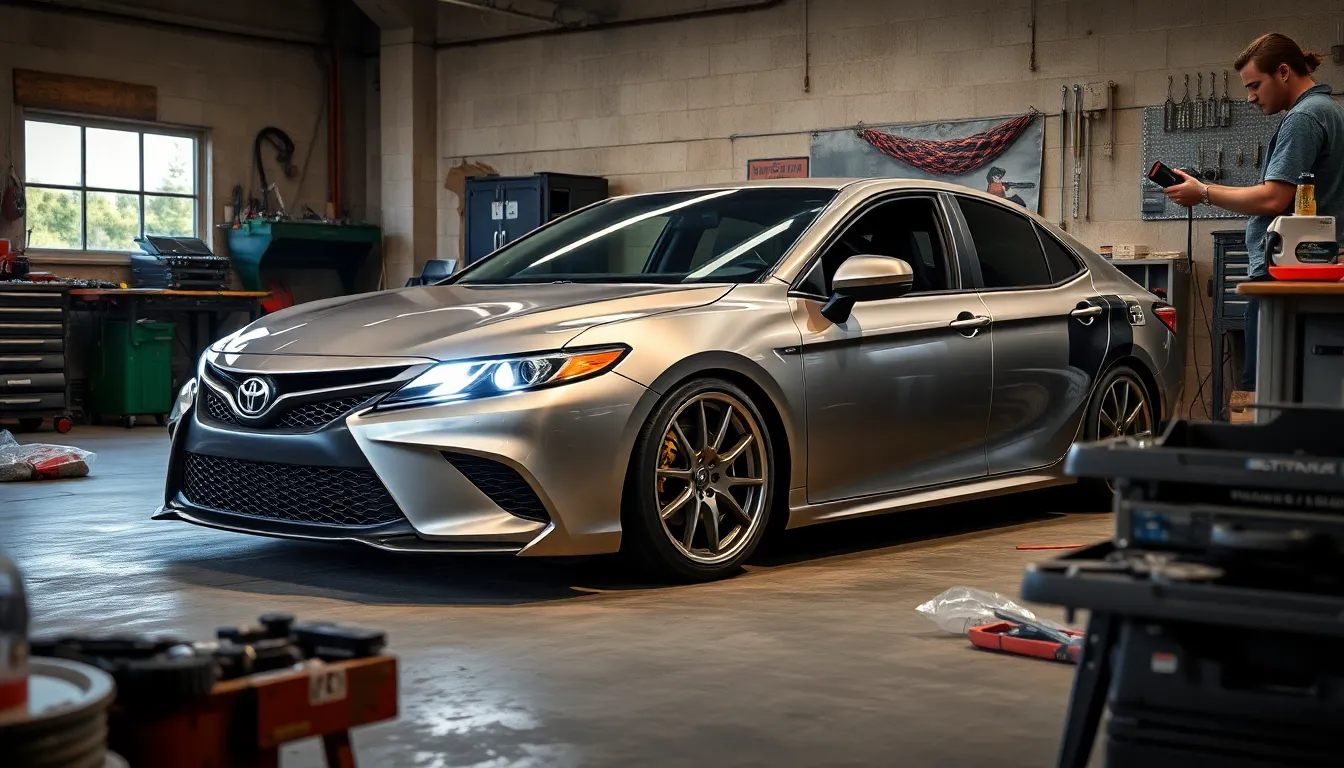
Budgeting for Toyota Camry modifications requires understanding the important price variations across different upgrade categories. Entry-level modifications start at $200-500 for basic appearance changes while comprehensive performance builds can exceed $15,000.
Budget-Friendly Modification Categories
Exterior enhancements offer the most cost-effective visual impact for modified Camry projects. Vinyl wraps range from $300-800 for partial coverage while complete color changes cost $1,500-3,000. Window tinting provides excellent value at $200-400 for professional installation across all windows. Basic spoilers and side skirts start at $150-300 for aftermarket options.
Interior modifications deliver substantial aesthetic improvements without major expenses. Seat covers range from $50-200 for quality materials while custom floor mats cost $100-250. Dashboard trim kits provide dramatic visual changes for $75-150. LED interior lighting packages enhance ambiance for $30-100 depending on the complexity.
Performance modifications require larger investments but deliver measurable improvements. Cold air intake systems cost $150-400 for reputable brands like K&N or AEM. Cat-back exhaust systems range from $400-1,200 for quality stainless steel construction. Performance chips and tuning software cost $300-800 for professional calibration.
Mid-Range Investment Options
Suspension upgrades represent the middle ground between affordability and performance enhancement. Lowering springs cost $200-500 for brands like Eibach Pro-Kit while complete coilover systems range from $800-2,500. Strut tower braces provide chassis stiffening for $100-300.
Wheel and tire combinations significantly impact both appearance and handling characteristics. Quality aftermarket wheels cost $150-400 each while performance tires add $120-250 per tire. Complete wheel and tire packages typically range from $1,200-2,800 for 18-19 inch setups.
Brake system upgrades enhance safety and performance simultaneously. Performance brake pads cost $100-250 per axle while slotted or drilled rotors add $150-300 per pair. Complete big brake kits with larger calipers range from $1,500-4,000.
High-End Modification Categories
Forced induction systems represent the most expensive performance modifications for Camry builds. Turbocharger kits cost $3,000-8,000 including installation while supercharger systems range from $4,000-12,000. Supporting modifications like fuel system upgrades add $1,000-3,000 to these projects.
Custom bodywork creates unique visual statements but requires substantial investment. Professional paint jobs cost $3,000-8,000 for quality work while custom body kits range from $2,000-6,000 before installation. Wide body conversions can exceed $10,000 including professional fitment and paint matching.
Audio system upgrades vary dramatically based on quality and complexity. Basic aftermarket stereo installations cost $300-800 while high-end custom systems with multiple amplifiers and subwoofers range from $2,000-8,000.
Installation and Labor Considerations
Professional installation costs significantly impact modification budgets across all categories. Basic installations like cold air intakes cost $100-200 while complex turbocharger systems require $2,000-4,000 in labor charges. Paint and bodywork installations typically double the parts cost.
DIY installations reduce costs substantially but require proper tools and experience. Simple modifications like intake systems take 2-3 hours while suspension work requires 6-8 hours and specialized equipment. Electrical modifications demand exact knowledge to avoid damage to modern Camry computer systems.
| Modification Category | Budget Range | Professional Installation | DIY Difficulty |
|---|---|---|---|
| Cold Air Intake | $150-400 | $100-200 | Easy |
| Exhaust System | $400-1,200 | $200-500 | Moderate |
| Lowering Springs | $200-500 | $400-800 | Difficult |
| Turbo Kit | $3,000-8,000 | $2,000-4,000 | Expert |
| Custom Paint | $3,000-8,000 | Included | Not Recommended |
| Wheel/Tire Package | $1,200-2,800 | $100-200 | Easy |
Long-Term Value Considerations
Modified Camry resale values depend heavily on modification quality and market appeal. Professional installations with reputable brands maintain better value retention compared to budget modifications. Conservative modifications like wheels and suspension typically add value while extreme modifications may limit buyer appeal.
Insurance implications affect long-term ownership costs for modified vehicles. Performance modifications may increase premium costs by 10-25% depending on the insurer and modification extent. Comprehensive coverage becomes essential for high-value modification investments.
Maintenance costs increase proportionally with modification complexity. Performance modifications require premium fluids and more frequent service intervals. Turbocharger systems add $500-1,000 annually in specialized maintenance requirements.
Conclusion
The Toyota Camry’s journey from reliable family transportation to modified enthusiast platform proves that performance potential exists in unexpected places. We’ve seen how this accessible sedan offers incredible versatility for customization projects of any scale or budget.
Whether you’re planning subtle daily driver enhancements or dreaming of a complete show car transformation the Camry delivers exceptional value. The combination of affordable pricing strong aftermarket support and proven reliability makes it an outstanding choice for your next modification project.
Your modified Camry awaits – it’s time to unlock its true potential and join the growing community of enthusiasts who’ve discovered what this platform can become.
Frequently Asked Questions
Why is the Toyota Camry popular for automotive modifications?
The Toyota Camry offers a robust platform with durable components and engineering tolerances that can handle increased power. Its spacious engine bay accommodates various modifications, while extensive aftermarket support from companies like AEM, K&N, and Injen ensures wide parts availability. The affordable base vehicle pricing and strong community support make it an ideal modification platform.
What are the most popular exterior modifications for a Toyota Camry?
Popular exterior modifications include body kits, aerodynamic features like splitters and spoilers, custom paint jobs, and vinyl wraps. Wheel and tire upgrades significantly impact both visual appeal and handling characteristics. These modifications can transform the Camry’s conservative appearance into a more aggressive, personalized statement while improving performance.
How much does it cost to modify a Toyota Camry?
Modification costs vary widely depending on the scope. Entry-level modifications start at $200-500, while comprehensive performance builds can exceed $15,000. Mid-range modifications typically cost $1,000-5,000. Budget-friendly options include cold air intakes and cosmetic upgrades, while high-end investments involve turbocharger installations and custom bodywork.
Can a modified Toyota Camry still be used as a daily driver?
Yes, modified Camrys can remain excellent daily drivers when modifications are chosen carefully. The 2.4L and 3.5L engine variants can handle moderate power increases without sacrificing reliability. Many enthusiasts successfully balance performance enhancements with practicality, maintaining the Camry’s renowned dependability while improving driving dynamics.
What performance modifications work best for Toyota Camrys?
Effective performance modifications include cold air intake systems, exhaust upgrades, engine tuning, and suspension improvements. The Camry’s platform accommodates both forced induction and naturally aspirated builds. Popular upgrades include turbocharger installations, coilover suspension systems, and engine management tuning, all of which can significantly enhance the driving experience.
Are there good aftermarket support and parts availability for Camry modifications?
Yes, the Toyota Camry enjoys excellent aftermarket support with numerous companies producing modification parts. Major brands like AEM, K&N, and Injen offer comprehensive product lines. Active online communities, forums, and social media groups provide extensive knowledge sharing, installation guides, and inspiration for unique builds, making modifications more accessible.

